跨文化交际重点梳理.docx
- 格式:docx
- 大小:10.33 KB
- 文档页数:9

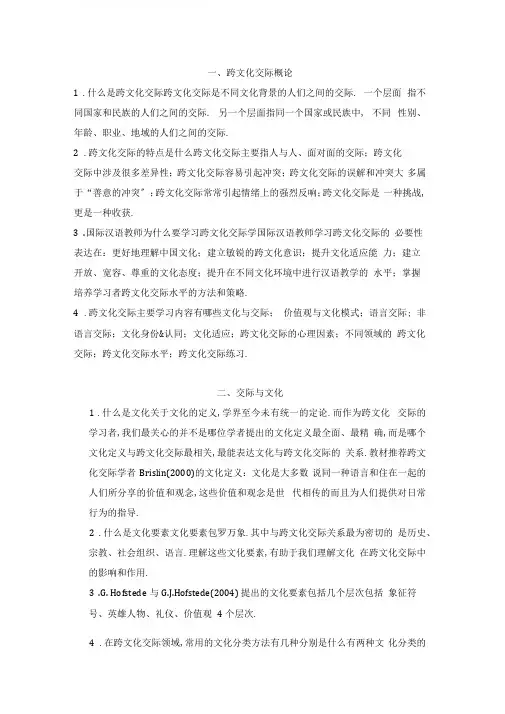
一、跨文化交际概论1.什么是跨文化交际跨文化交际是不同文化背景的人们之间的交际. 一个层面指不同国家和民族的人们之间的交际. 另一个层面指同一个国家或民族中, 不同性别、年龄、职业、地域的人们之间的交际.2.跨文化交际的特点是什么跨文化交际主要指人与人、面对面的交际;跨文化交际中涉及很多差异性;跨文化交际容易引起冲突;跨文化交际的误解和冲突大多属于“善意的冲突〞;跨文化交际常常引起情绪上的强烈反响;跨文化交际是一种挑战,更是一种收获.3.国际汉语教师为什么要学习跨文化交际学国际汉语教师学习跨文化交际的必要性表达在:更好地理解中国文化;建立敏锐的跨文化意识;提升文化适应能力;建立开放、宽容、尊重的文化态度;提升在不同文化环境中进行汉语教学的水平;掌握培养学习者跨文化交际水平的方法和策略.4.跨文化交际主要学习内容有哪些文化与交际;价值观与文化模式;语言交际; 非语言交际;文化身份&认同;文化适应;跨文化交际的心理因素;不同领域的跨文化交际;跨文化交际水平;跨文化交际练习.二、交际与文化1.什么是文化关于文化的定义,学界至今未有统一的定论.而作为跨文化交际的学习者,我们最关心的并不是哪位学者提出的文化定义最全面、最精确,而是哪个文化定义与跨文化交际最相关,最能表达文化与跨文化交际的关系.教材推荐跨文化交际学者Brislin(2000)的文化定义:文化是大多数说同一种语言和住在一起的人们所分享的价值和观念,这些价值和观念是世代相传的而且为人们提供对日常行为的指导.2.什么是文化要素文化要素包罗万象.其中与跨文化交际关系最为密切的是历史、宗教、社会组织、语言.理解这些文化要素,有助于我们理解文化在跨文化交际中的影响和作用.3.G. Hofstede与G.J.Hofstede(2004) 提出的文化要素包括几个层次包括象征符号、英雄人物、礼仪、价值观4个层次.4.在跨文化交际领域,常用的文化分类方法有几种分别是什么有两种文化分类的方法在跨文化交际领域最为常用.一种是客观文化与主观文化.另二种是主导文化与亚文化.5.文化有什么特点呢〔1〕文化是后天习得的.〔2〕文化是共享的,并世代相传.〔3〕大局部文化是无意识的.〔4〕文化是象征的.〔5〕文化是动态的.6.什么是交际与文化的定义相似,关于交际的定义也非常丰富和复杂.教材仅推荐与跨文化交际语用领域相关的定义.即Gudykunst& Kim〔2003〕提出的关于交际的定义:交际是编码和解码的过程,但是这种编码和解码的过程并非单纯的传递和接受过程,而是包含着意义的协商和共建.7.交际的要素是什么交际是互相交往的过程,交际的全部过程包含以下要素:传送者、信息、编码、解码、媒介、反响、噪音.8.交际有什么特点〔1〕交际是象征的〔2〕交际是动态的过程〔3〕交际涉及意义的协商和共建〔4〕交际发生在意识的各个层面.〔5〕交际是特定语境中发生的.9.文化对交际有什么影响文化从两个层面影响交际:一是从文化标准的层面,二是从个人层面.文化影响着人们的感知.首先, 文化影响人们对外部刺激的选择.其次,文化影响人们对外部刺激的分类.第三,文化影响人们对外部刺激的意义联想.最后,文化影响人们对外部刺激的解释.文化的特征值是它为行为提供指南.文化影响人们的饮食行为.文化还影响人们的衣着打扮.文化影响居住方式.文化影响人们的出行方式.文化也影响了人与人交往的方式.1.什么是价值观价值观不是实际的行为, 而是关于行为的规那么;价值观是一套关于什么是真善美的标准系统;这些规那么和标准是用来判断和指导人们的行为的;价值观不是个人的爱好或倾向,而是一种集体的文化意识.2.价值观如何分类一类是终极性价值观, 它是关于生命、生存等终极目标的价值观,另一类是工具性价值观,它是关于道德和水平的价值观.3.价值观有什么特点〔1〕价值观属于深层文化.〔2〕价值观是人们的行为指南. 〔3〕价值观既是稳定的,也是变化的.〔4〕不同文化的价值观既有相同的也有不同的成分.〔5〕价值观被违背时会引起情感上的强烈反响.4.关于价值观模式的研究具有影响力的理论是哪些1.价值取向理论〔由kluckhohn与Strodtbeck提出〕2.文化尺度〔由Hofstede提出〕3.高语境文化与低语境文化〔由Hall提出〕.5.中国文化模式有什么特点〔 1〕集体主义〔2〕以家庭为中央〔3〕尊重传统〔4〕等级观念〔5〕面子观念〔6〕重视人情6.美国文化模式有什么特点〔 1〕个体主义〔2〕平等观念〔3〕强调变化和进步〔4〕物质享受〔5〕科学与技术〔6〕工作与娱乐〔7〕竞争意识四、跨文化的语言交际1概念提要:1.萨丕尔-沃尔夫假说的含义萨丕尔-沃尔有三层含义.〔1〕不同的语言以不同的方式感知和划分世界.〔2〕一个人所使用的语言结构影响他感知和理解世界的方式.〔3〕讲不同语言的人感知世界是不同的.2.语言与价值观之间是什么关系语言与文化的关系最直接的表达是语言表达了人们对世界的看法、态度和价值取向.每种语言都拥有丰富的格言、警句和俗语.这些句子往往就是价值观的表达.3.词义与文化是什么关系在语言的各要素中,词汇与文化的关系最为密切,其对跨文化交际的影响也最为突出.语言的含义不具有普遍性,它受到文化和语境的制约.不同语言和文化的人们进行跨文化交际时,可能会由于对词语含义的误解而产生交流的障碍.4.什么叫委婉语学习它有什么意义禁忌是人类社会普遍存在的文化现象, 人们对诸如生老病死、隐私等许多方面多有避讳,因此产生了大量的委婉语. 了解不同文化中的禁忌和相应的委婉语不仅可以深入理解不同文化的价值取向,也可以防止在跨文化交际中出现不必要的误会.四、跨文化的语言交际2概念提要:1.礼貌原那么包括哪些准那么〔1〕得体准那么〔2〕慷慨准那么〔3〕赞扬准那么〔4〕谦虚准那么〔5〕一致准那么〔6〕同情准那么.2.中国人的礼貌特征包括哪些〔1〕贬己尊人〔2〕称呼准那么〔3〕文雅准那么〔4〕求同准那么〔5〕德、言、行准那么.3.礼貌策略的使用受到什么因素的制约〔1〕说话人与听话人之间的权力距离〔2〕说话人与听话人之间的社会距离〔3〕言语行为的强加程度4.什么是交际风格交际风格是指说话的特点.5.在跨文化交际领域中,常见的交际风格包括哪些〔1〕直接与间接的交际风格〔2〕谦虚与自信的交际风格〔3〕归纳与演绎的交际风格五、跨文化的非语言交际概念提要:1.什么是非言语交际非言语交际不包括语言,而是包括了各种非语言的交际行为;非语言交际具有互动性,涉及信息的发出者和接受者的编码和解码过程;非言语交际是在特定情境中产生的,与语境有密切关系;非语言交际可能是有意的,也可能是无意的.2.非语言交际的功能有哪些〔 1〕传达真实的内在感情〔2〕营造交际印象〔3〕进行会话治理3.非语言交际与语言交际是什么关系非语言交际对语言信息起着重复、补充、代替、标准和否认等作用.4.体态语包括哪些人们的外貌服饰、面部表情、眼神交流、手势、姿势以及身体接触都是体态语,都参与了交际,是非语言交际的一局部.5.时间观念与文化之间有什么联系时间观念是非语言交际的重要维度, 也是价值观的表达.6.什么是单时制文化其特点是什么单时制文化中的时间是线性的,可以向前延伸到未来,向后延伸到过去.单时制文化的人们通过方案和预约来限制时间,在一段时间内只做一件事,强调准时、预约和最后期限.7.什么是多时制文化其特点是什么多时制文化并不把时间看做是线性的.多时制文化中的人认为时间围绕着生活,在同一时间内可以做多件事情.工作常常被打断,方案也常改变.身处多时制文化中的人,维系人际关系和谐远比遵守时间重要.8.人们对于空间的利用与文化之间有什么联系空间利用也是非语言交际的重要内容.空间利用方式表达了特定文化中人际关系的特点.六、文化适应概念提要:1.文化适应策略有哪些同化、别离、融合以及边缘化.2.文化适应是一个复杂、动态的开展过程.短期旅居者的跨文化适应过程分为哪几个阶段蜜月期、挫折期、恢复期和适应期.3.焦虑处理理论认为什么因素影响跨文化适应个体性格因素、社会支持、性别、民族、处理文化适问题的策略等.4.什么是文化休克文化休克是一种因失去了熟悉的社会交往符号而产生的心理焦虑.5.应对文化休克可采取什么策略应对呢广交朋友,建立良好人际关系;学习目的国的语言;了解目的文化的知识;做自己感兴趣的事情;参加社会文化活动;改变自己的思维.6.什么是文化适应假说第二语言教学领域的学者很早注意到了文化适应与第二语言学习的关系.Schuman(1986跟出了文化适应假说〞.他认为, 学习者只有适应了第二文化以后才能习得第二语言,文化适应的程度决定第二语言学习的程度.7.Schuman(198觎出的社会距离的概念是什么社会距离指的是学习者的原有文化与目的语文化之间的差异程度.七、跨文化的人际交往概念提要:1.人际关系与文化的联系表达在哪几方面不同文化间的朋友关系、人情关系、工作关系、与陌生人之间的关系都受到文化的影响.2.交往习俗与文化之间有什么联系在社会交往中,人们需要遵循社交礼仪和规那么,而这些规那么会因文化而异.一种文化中得体、礼貌的规那么到了另一种文化中可能是不得体的,甚至还造成了冒犯.了解不同文化的社交习俗和礼仪,对提升跨文化交际的有效性和得体性是非常有必要的.3.公共礼仪与文化之间有什么联系遵守公共秩序和礼仪是现代人的基本素养,也是一个国家文明程度的表达. 在跨文化交往中,了解和遵守不同文化的公共礼仪非常重要.不遵守公共礼仪会给人留下负面的印象,甚至引起跨文化交往中的冲突.八、跨文化人际交际的心理与态度概念提要:1.什么是刻板印象刻板印象又作成见〞与谊型观念〞,是指一个群体成员特征的概括性看法.2.刻板印象有什么特点〔1〕刻板印象是人们正常思维的一局部.〔2〕刻板印象是文化的一局部.〔3〕刻板印象的最大局限是以偏概全,无视个体差异.3.如何克服刻板印象〔1〕意识到刻板印象的存在.〔2〕改变懒惰和简化的思维习惯.〔3〕扩大与不同文化的人的接触范围.〔4〕试图寻找充分的证据和例外的情况.〔5〕对于来自其他文化的个人的行为的描述,应采用表达性语言,而不是对这一文化群体进行评价和简单概括.4.什么是偏见偏见是对一个群体的成员建立在错误而僵化的概括根底上的负面感情5.如何克服偏见〔1〕坦诚面对自己的偏见.〔2〕扩大与不同文化的人的接触范围.〔3〕参加课程学习和培训.〔4〕在交际中防止使用带有偏见或歧视色彩的表达方式,特别是对弱势群体要注意使用委婉而礼貌的称呼.6.什么是种族中央种族中央指的是在思考和评价别的文化时,把自己的文化放在一切事物的中央位置,并且以自己文化的框架作为衡量的标准.7.什么是文化相对主义文化相对主义是与种族中央主义相对的概念.它最早由美国著名人类学家弗朗兹博厄斯所倡导.其包括两个方面的内容.第一, 每种文化都有自己长期形成的独特历史, 其形态并无上下之分;第二,任何一个民族都有自己的社会思想、世界观和道德观,人们不应该用自己的一套标准来衡量其它民族的文化.。
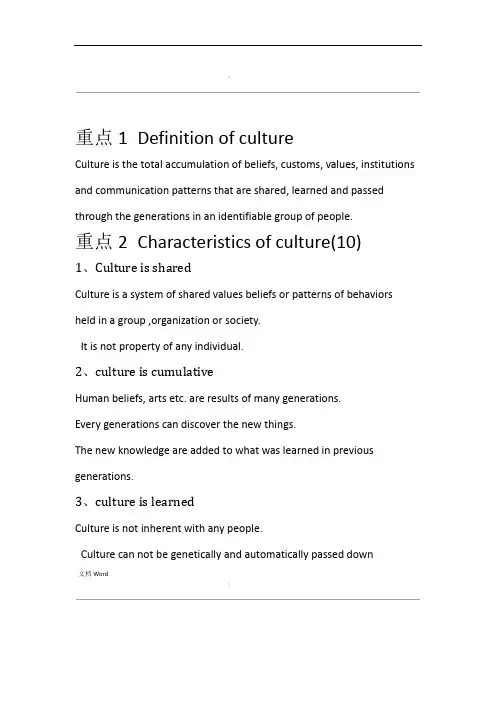
`重点1Definition of cultureCulture is the total accumulation of beliefs, customs, values, institutions and communication patterns that are shared, learned and passed through the generations in an identifiable group of people.重点2Characteristics of culture(10)1、Culture is sharedCulture is a system of shared values beliefs or patterns of behaviors held in a group ,organization or society.It is not property of any individual.2、culture is cumulativeHuman beliefs, arts etc. are results of many generations.Every generations can discover the new things.The new knowledge are added to what was learned in previous generations.3、culture is learnedCulture is not inherent with any people.Culture can not be genetically and automatically passed down文档Word`from previous generations.And it should be taught and learned by people.4、culture is adaptiveCulture is created by humans. Humans have to adapt the environment . thus is in development bears the trait of being adaptive 5、culture is dynamicAt the same time that new culture are added, and the old ones are lost because they are no longer useful.6、culture is symbolicSymbols generally serve as communicative tools for a multitude purposes, on a persons as well as culture level.7 、culture is relationalCulture is an organic whole. All the components of culture are interlinked.8 、culture is implicit and explicitSome layers culture are easy to be observe, like eating , dressing, talking. But the ideas underlying the behaviors are generally hard to know. Many scholars label the culture as iceberg.文档Word`culture is universal 9、culture is diversified、10Hall's dimensions3重点High contextHigh-context communication relies heavily on nonverbal, contextual and shared cultural meanings.The meanings are not fully expressed.re determined by “how”things are said , rather than “what”Meanings ais said.阿拉伯欧洲东部和南部日本CollectivismLow contextVerbal codes rather than the information impliesClear straight and to-the-point communication美国德国斯堪的纳维亚IndividualismMonochromic cultureDo one thing at one time, Concentrate on the job, take time seriously, 文档Word`low-context and need information, commit to the job, religiously to the plans, not disturbing others, seldom borrow or lend things, emphasize promptnessPolychromic cultureDo many things at once, subject to interruptions, consider timecommitments an objective to be achieved, high-context and already haveinformation. Change plans often. Emphasize the relationships.重点4Triandis's individualism & collectivismIndividualismFosters independence and individual achievement,Promotes self-expression ,personal choice, individual thinking Associated with egalitarian relationships and flexibility in roles Understand the physical world as knowable apart of human life CollectivismInterdependence and group successPromotes adherence to normsAssociated with stable, hierarchical rolesShared property, group ownership文档Word`重点5Elements of communication Source (sender)EncodingMessageMedium(channel)ReceiverDecodingResponseFeedback重点6Grice's cooperative principle Quantity maximMake your contribute as informative as is required for the current purpose of exchange.Do not make your contribution more information than is required. (量的准则——话语提供充分而不多余的信息)Quality maximMake your contribution is ture(质的准则——话语的容是真实的)文档Word`Relation maximBe relevant(关系准则——话语与话题有关,即与所要实现的意图有关)Manner maximBe perspicuousAvoid obscurity of expressionAvoid ambiguityDe brief and orderly(方式准则——说话要清楚明白、简洁而有条理)重点7Brown & levinson's face theory Face is something that is emotionally invested, can be lost, maintained, or enhanced, and must be often attended to in communication People cooperate while maintaining face in interaction.Face theory : face threatening acts (FTAs)Politeness strategiesPoliteness strategies: bald on-record赤裸裸的公开实行面子威胁行为不使用补救措施off-record indirect strategy 非公开的实行面子威胁行为negative politeness消极礼貌策略Positive politeness积极礼貌策略文档Word`Face: negative facePositive face重点8Thought patternsField dependence场依存性Holistic thinking eastern peoplePerspective of the whole, all the relevant parts take into account.Easily influence by othersField independence场独立性Analytic thinking western peopleDivinding the whole into parts to analyze the features or relations between the partsHardly influence by othersEastern: field-dependence, holistic thinking, high-context Western: field-independence, analytic thinking, low-context文档Word`重点9Phases of negotiation Preparation 准备Non-task sounding 非任务测探Task-oriented exchangePersuasion 劝说ConcessionConclusion重点10Components of a brandBrand name 品牌名称(产品)Brand mark 品牌标志(产品)Trade name商号(公司名字)Trade mark 品牌商标重点11SWOT analysisStrengthsWeaknessesOpportunitiesThreats文档Word`重点12Intercultural advertising strategies Standardization strategyConvey and extend the same advertising message to different markets and culturesKey point:Deal with the different markets using the same massageExample:MarlboroPhilips优点:reinforce the corporate imageSaving energyBe convenient to manage compared with several ads缺点: unlikely to be adaptive without change to all foreign culture Result in misunderstanding or conflict even ruin a business Localization strategyStresses the specialties of the local market and adaptation to the local market environment文档Word`重点13Three meaning layers of adsthe surface meaningthe intended meaningthe cultural meaning文档Word。
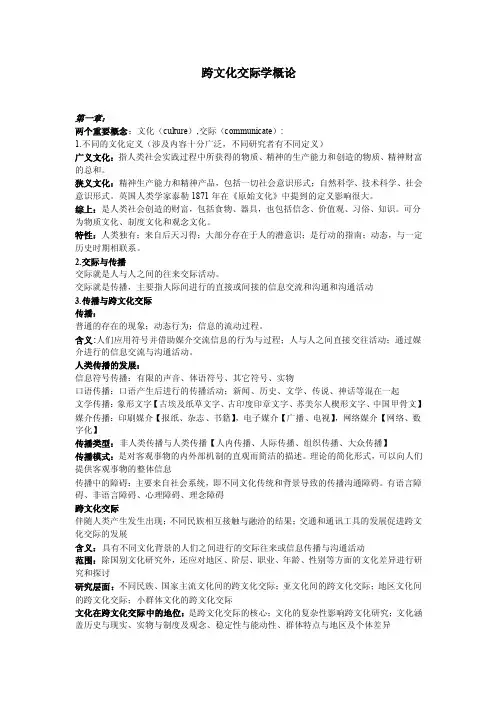
跨文化交际学概论第一章:两个重要概念:文化(culture),交际(communicate):1.不同的文化定义(涉及内容十分广泛,不同研究者有不同定义)广义文化:指人类社会实践过程中所获得的物质、精神的生产能力和创造的物质、精神财富的总和。
狭义文化:精神生产能力和精神产品,包括一切社会意识形式;自然科学、技术科学、社会意识形式。
英国人类学家泰勒1871年在《原始文化》中提到的定义影响很大。
综上:是人类社会创造的财富,包括食物、器具,也包括信念、价值观、习俗、知识。
可分为物质文化、制度文化和观念文化。
特性:人类独有;来自后天习得;大部分存在于人的潜意识;是行动的指南;动态,与一定历史时期相联系。
2.交际与传播交际就是人与人之间的往来交际活动。
交际就是传播,主要指人际间进行的直接或间接的信息交流和沟通和沟通活动3.传播与跨文化交际传播:普通的存在的现象;动态行为;信息的流动过程。
含义:人们应用符号并借助媒介交流信息的行为与过程;人与人之间直接交往活动;通过媒介进行的信息交流与沟通活动。
人类传播的发展:信息符号传播:有限的声音、体语符号、其它符号、实物口语传播:口语产生后进行的传播活动;新闻、历史、文学、传说、神话等混在一起文学传播:象形文字【古埃及纸草文字、古印度印章文字、苏美尔人楔形文字、中国甲骨文】媒介传播:印刷媒介【报纸、杂志、书籍】,电子媒介【广播、电视】,网络媒介【网络、数字化】传播类型:非人类传播与人类传播【人内传播、人际传播、组织传播、大众传播】传播模式:是对客观事物的内外部机制的直观而简洁的描述。
理论的简化形式,可以向人们提供客观事物的整体信息传播中的障碍:主要来自社会系统,即不同文化传统和背景导致的传播沟通障碍。
有语言障碍、非语言障碍、心理障碍、理念障碍跨文化交际伴随人类产生发生出现;不同民族相互接触与融洽的结果;交通和通讯工具的发展促进跨文化交际的发展含义:具有不同文化背景的人们之间进行的交际往来或信息传播与沟通活动范围:除国别文化研究外,还应对地区、阶层、职业、年龄、性别等方面的文化差异进行研究和探讨研究层面:不同民族、国家主流文化间的跨文化交际;亚文化间的跨文化交际;地区文化间的跨文化交际;小群体文化的跨文化交际文化在跨文化交际中的地位:是跨文化交际的核心;文化的复杂性影响跨文化研究;文化涵盖历史与现实、实物与制度及观念、稳定性与能动性、群体特点与地区及个体差异影响跨文化交际的主要因素:民族的历史与传统、宗教思想、价值观念、社会组织形式、风俗习惯、政治制度、社会发展阶段第二章:文化感知与价值观一、文化感知感知1、感觉:感官对刺激对象个别属性的直接反映,最简单的心理过程2、知觉:根据感觉所获信息作出的心理反应。
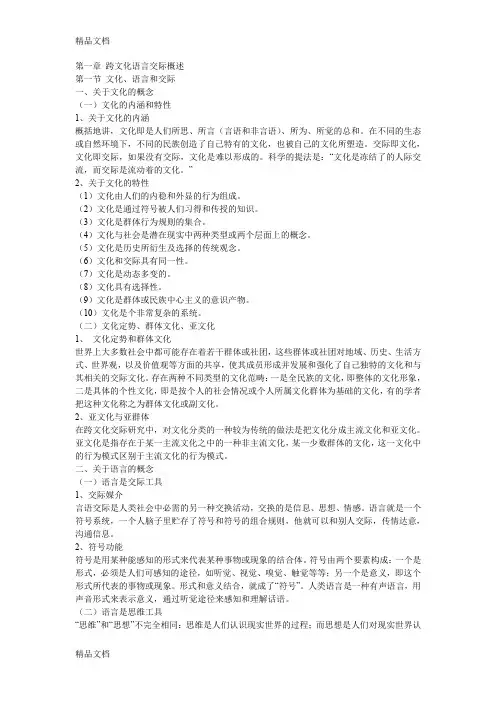
第一章跨文化语言交际概述第一节文化、语言和交际一、关于文化的概念(一)文化的内涵和特性1、关于文化的内涵概括地讲,文化即是人们所思、所言(言语和非言语)、所为、所觉的总和。
在不同的生态或自然环境下,不同的民族创造了自己特有的文化,也被自己的文化所塑造。
交际即文化,文化即交际,如果没有交际,文化是难以形成的。
科学的提法是:“文化是冻结了的人际交流,而交际是流动着的文化。
”2、关于文化的特性(1)文化由人们的内稳和外显的行为组成。
(2)文化是通过符号被人们习得和传授的知识。
(3)文化是群体行为规则的集合。
(4)文化与社会是潜在现实中两种类型或两个层面上的概念。
(5)文化是历史所衍生及选择的传统观念。
(6)文化和交际具有同一性。
(7)文化是动态多变的。
(8)文化具有选择性。
(9)文化是群体或民族中心主义的意识产物。
(10)文化是个非常复杂的系统。
(二)文化定势、群体文化、亚文化1、文化定势和群体文化世界上大多数社会中都可能存在着若干群体或社团,这些群体或社团对地域、历史、生活方式、世界观,以及价值观等方面的共享,使其成员形成并发展和强化了自己独特的文化和与其相关的交际文化。
存在两种不同类型的文化范畴:一是全民族的文化,即整体的文化形象,二是具体的个性文化,即是按个人的社会情况或个人所属文化群体为基础的文化,有的学者把这种文化称之为群体文化或副文化。
2、亚文化与亚群体在跨文化交际研究中,对文化分类的一种较为传统的做法是把文化分成主流文化和亚文化。
亚文化是指存在于某一主流文化之中的一种非主流文化,某一少数群体的文化,这一文化中的行为模式区别于主流文化的行为模式。
二、关于语言的概念(一)语言是交际工具1、交际媒介言语交际是人类社会中必需的另一种交换活动,交换的是信息、思想、情感。
语言就是一个符号系统,一个人脑子里贮存了符号和符号的组合规则,他就可以和别人交际,传情达意,沟通信息。
2、符号功能符号是用某种能感知的形式来代表某种事物或现象的结合体。
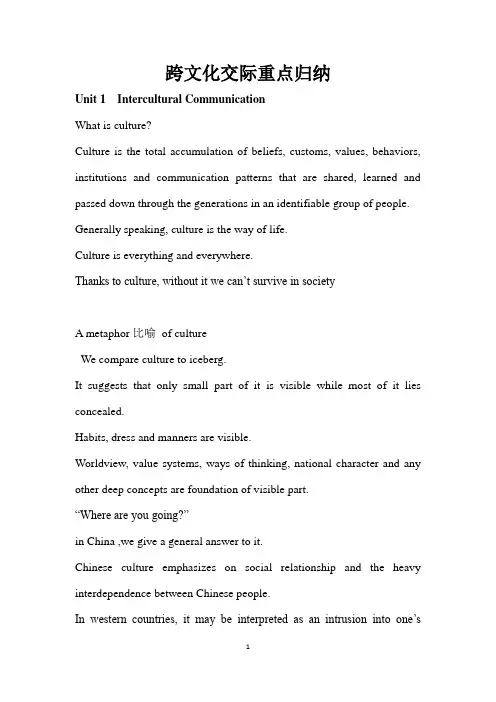
跨文化交际重点归纳Unit 1 Intercultural CommunicationWhat is culture?Culture is the total accumulation of beliefs, customs, values, behaviors, institutions and communication patterns that are shared, learned and passed down through the generations in an identifiable group of people. Generally speaking, culture is the way of life.Culture is everything and everywhere.Thanks to culture, without it we can’t survive in societyA metaphor比喻of cultureWe compare culture to iceberg.It suggests that only small part of it is visible while most of it lies concealed.Habits, dress and manners are visible.Worldview, value systems, ways of thinking, national character and any other deep concepts are foundation of visible part.“Where are you going?”in China ,we give a general answer to it.Chinese culture emphasizes on social relationship and the heavy interdependence between Chinese people.In western countries, it may be interpreted as an intrusion into one’sprivacy.The underlying individual-oriented relationship is the invisible part of the iceberg.exercise1. If you are a tourist guide, what are you expected to say when you are showing the foreign visitors to another site?A. This way, please.B. Come here, please.C. Follow me, please.D. Move on.2. A visitor stops you in the corridor of your head-office probably to ask for the way. What is your most likely reply to the visitor’s “Excuse me”?A. What’s the matter?B. Yes?C. That’s all right.D. Don’t worry.3. At a fair, a visitor, accidentally having knocked down your poster, says, “I’m terribly sorry.” What should you reply?A. It doesn’t matter.B. Never mind.C. Don’t worry.D. That’s all right.What is Intercultural communication?“Intercultural communication is contact between persons who identify themselves as distinct from one another in cultural terms.” (Collier & Thomas, 1998)intercultural communication refers to any communication between two members of any cultural communities. (Samovar & Porter)To further understand “intercultural communication”, please read the section of “Intercultural Communication Reading” on P.2 and answer the questions:1 In the story, why does Pete could not communicate well with Chinese students?Language problemCulture problemThe way Pete handled the intercultural communication situation2 What are the major barriers in intercultural communication? Language difference.(If we understand others’ language or dialect, but not their communication rules, we can made fluent fools of ourselves.) Nonverbal communication: gestures, postures, facial expression etc. Stereotypes: like culture, religion, idea, value, etc.Watch a video and get a deeper understanding.Classifications of Communicationverbal /nonverbalDirect /indirectInterpersonal / interorganizational / mass media-basedIntracultural /interculturalIntrapersonal / interpersonal/…Case studyRead the passage of “ an Intercultural Classroom”. This is the beginning of this passage:It was a hot day. Since it was still too early to use the air-conditioner, according to the regulations of the university, every class kept its door open to make the classroom cooler. While I was lecturing on Chinese grammar in Class 4, waves of laughter came from the neighboring Class 5. A German student named Stephen raised his hand and stood up. “The laughter from Class 5 is bothering us. I think we should go to their class to protest,” he said….1 How many different solutions did Class 4 propose?2 what is the mode of communication favored by Asians? What cultural values underlie it?Asian people are very courteous and indirect in their communications. They put great emphasis on group harmony, they are very tolerant, even when they are offended. These collectivistic values, shaped by Confusion teachings, were spread from China to many Asian countries.3 what is the mode of communication favored by Westerners? What cultural values underlie it?Westerners are generally very direct and frank in their mode ofcommunication. And they have a strong sense of protecting their own rights. Individualistic values are the underlying principles governing their behavior.Classroom activity 11. Read the story on P1 and answer: Why do you think the driver is asking for $50 instead of $32.5?2. Work in groups and write down 5 ways to deal with the situation. Some likely interpretationsThe taxi driver is trying to cheat Lee.extra charges for luggage that Lee doesn’t know about.Extra charges for tolls that Lee doesn’t know.There is an honest misunderstanding.L ee misunderstood what the driver said, or didn’t hear what he said clearly.The driver has included a tip for himself –an unreasonably large one. Culture NoteTaxi charges: in taxis in the us, it is quite normal to have a small extra charge for each of luggage. In the us there are also sometimes tolls for bridges, tunnels and certain roads. and the taxi driver will pay these first and then add them to the cost of the ride.Tipping: in the us it is normal to add a tip of 10%-15% to the cost of a taxi ride. (tipping is not normal in fast-food restaurants where customs gettheir own food.Taxis in the Us: while taxis can often be found at Us airports, taxis are rare in all but the largest American cities, and to get a taxi people often need to call a taxi company. This is because most Americans drive their cars. (in large cities, taxi drivers are often immigrants form other countries who do not speak English as their first language.)Classroom activity 2Read Letter to Fran: Not Eating and answer the following questions.1. Why did Nancy eat so little?2. Tell the possible reasons for Nancy’s problem.Possible reasonsOn the whole, American cooking tends to be somewhat more bland than the cooking in most parts of China.Some westerners have allergic reactions to MSG(often used in Chinese cooking) and get headaches if they eat food containing it.Some Christians won’t drink alcoholic beverages.Read Fran’s Response: Not Eating after class and get more information. Discuss the differences of table manners between Chinese and Westerners.Chinese people often use words like color 、smell 、taste、shape to describe the food.Westerners usually pay more attention to the calories、vitamins、proteinsand so on.we would invite many people “the more the better”If the host respect you ,he will give you a seat at first and sit on the left chair .The host will prepare all the things ready. The host will get delicious food into the guest’s bowl .Westerners would like to keep quiet. They regard the right as a symbol of respect.The host will let the guests choose what to eat or drink.Individualist and CollectivistWhat are the characteristics of Individualist and Collectivist? Classroom activity 3Read the passage Individualist and Collectivist Cultures and finish the following tasks.What are some differences between an individualist culture and a collectivist one?find out ways of how do Chinese show individualism and how do westerners show their collectivism. You may need to supply your points with examples.Assignment:Review unit 1 and Preview unit 2Work in teams of 6 and deliver a presentation on following topics:What are differences between an individualist culture and a collectivistone?find out ways of how do Chinese show individualism and how do westerners show their collectivism. You may need to supply your points with examples.Unit 2Review: Interpretation解释、翻译of greetings上哪去?Where are you going?It’s none of your business!去哪啦?Where have you been?吃过了吗?Have you had your meal?Are you going to invite me to dinner?Acceptable Greetings中文出去呀?吃饭去?回来了?忙着呢?忙什么呢?在洗车呀?这衣服真漂亮,新买的吧?你看起来气色不错。
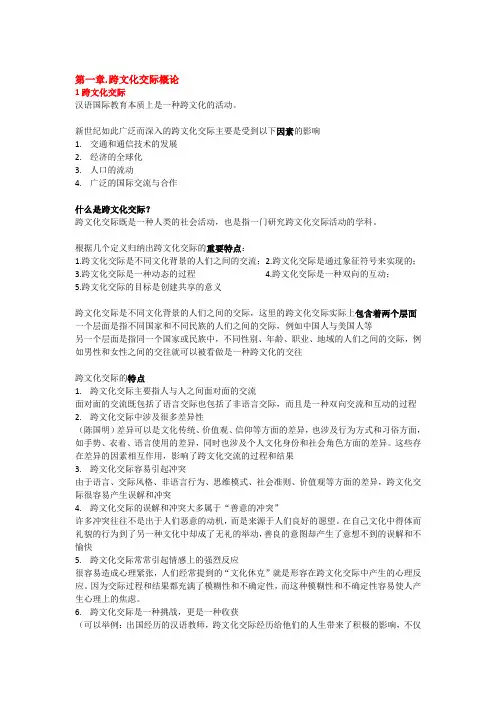
第一章.跨文化交际概论1跨文化交际汉语国际教育本质上是一种跨文化的活动。
新世纪如此广泛而深入的跨文化交际主要是受到以下因素的影响1.交通和通信技术的发展2.经济的全球化3.人口的流动4.广泛的国际交流与合作什么是跨文化交际?跨文化交际既是一种人类的社会活动,也是指一门研究跨文化交际活动的学科。
根据几个定义归纳出跨文化交际的重要特点:1.跨文化交际是不同文化背景的人们之间的交流;2.跨文化交际是通过象征符号来实现的;3.跨文化交际是一种动态的过程4.跨文化交际是一种双向的互动;5.跨文化交际的目标是创建共享的意义跨文化交际是不同文化背景的人们之间的交际,这里的跨文化交际实际上包含着两个层面一个层面是指不同国家和不同民族的人们之间的交际,例如中国人与美国人等另一个层面是指同一个国家或民族中,不同性别、年龄、职业、地域的人们之间的交际,例如男性和女性之间的交往就可以被看做是一种跨文化的交往跨文化交际的特点1.跨文化交际主要指人与人之间面对面的交流面对面的交流既包括了语言交际也包括了非语言交际,而且是一种双向交流和互动的过程2.跨文化交际中涉及很多差异性(陈国明)差异可以是文化传统、价值观、信仰等方面的差异,也涉及行为方式和习俗方面,如手势、衣着、语言使用的差异,同时也涉及个人文化身份和社会角色方面的差异。
这些存在差异的因素相互作用,影响了跨文化交流的过程和结果3.跨文化交际容易引起冲突由于语言、交际风格、非语言行为、思维模式、社会准则、价值观等方面的差异,跨文化交际很容易产生误解和冲突4.跨文化交际的误解和冲突大多属于“善意的冲突”许多冲突往往不是出于人们恶意的动机,而是来源于人们良好的愿望。
在自己文化中得体而礼貌的行为到了另一种文化中却成了无礼的举动,善良的意图却产生了意想不到的误解和不愉快5.跨文化交际常常引起情感上的强烈反应很容易造成心理紧张,人们经常提到的“文化休克”就是形容在跨文化交际中产生的心理反应。
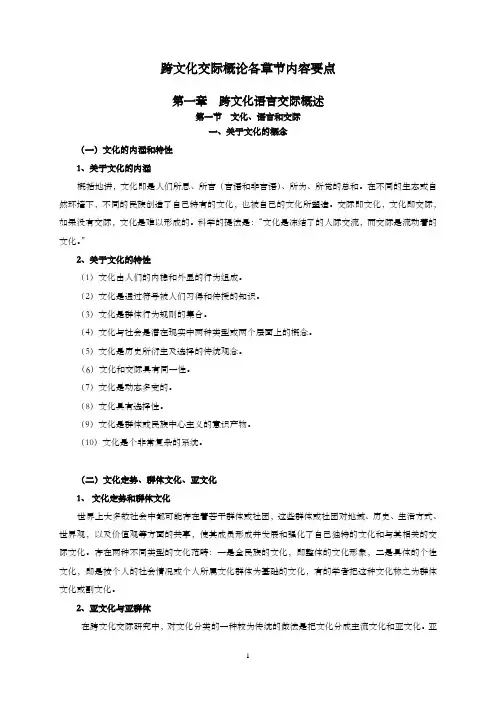
跨文化交际概论各章节内容要点第一章跨文化语言交际概述第一节文化、语言和交际一、关于文化的概念(一)文化的内涵和特性1、关于文化的内涵概括地讲,文化即是人们所思、所言(言语和非言语)、所为、所觉的总和。
在不同的生态或自然环境下,不同的民族创造了自己特有的文化,也被自己的文化所塑造。
交际即文化,文化即交际,如果没有交际,文化是难以形成的。
科学的提法是:“文化是冻结了的人际交流,而交际是流动着的文化。
”2、关于文化的特性(1)文化由人们的内稳和外显的行为组成。
(2)文化是通过符号被人们习得和传授的知识。
(3)文化是群体行为规则的集合。
(4)文化与社会是潜在现实中两种类型或两个层面上的概念。
(5)文化是历史所衍生及选择的传统观念。
(6)文化和交际具有同一性。
(7)文化是动态多变的。
(8)文化具有选择性。
(9)文化是群体或民族中心主义的意识产物。
(10)文化是个非常复杂的系统。
(二)文化定势、群体文化、亚文化1、文化定势和群体文化世界上大多数社会中都可能存在着若干群体或社团,这些群体或社团对地域、历史、生活方式、世界观,以及价值观等方面的共享,使其成员形成并发展和强化了自己独特的文化和与其相关的交际文化。
存在两种不同类型的文化范畴:一是全民族的文化,即整体的文化形象,二是具体的个性文化,即是按个人的社会情况或个人所属文化群体为基础的文化,有的学者把这种文化称之为群体文化或副文化。
2、亚文化与亚群体在跨文化交际研究中,对文化分类的一种较为传统的做法是把文化分成主流文化和亚文化。
亚文化是指存在于某一主流文化之中的一种非主流文化,某一少数群体的文化,这一文化中的行为模式区别于主流文化的行为模式。
二、关于语言的概念(一)语言是交际工具1、交际媒介言语交际是人类社会中必需的另一种交换活动,交换的是信息、思想、情感。
语言就是一个符号系统,一个人脑子里贮存了符号和符号的组合规则,他就可以和别人交际,传情达意,沟通信息。

跨文化交际重点梳理跨文化交际是指在不同文化背景下进行交流和互动。
在一个全球化的世界中,跨文化交际变得越来越重要。
跨文化交际的目标是建立和维持不同文化之间的理解和合作关系。
然而,由于不同文化之间的差异,跨文化交际面临着许多挑战。
本文将重点梳理跨文化交际的关键点。
第一点是尊重和理解。
在跨文化交际中,尊重对方的文化背景和价值观是非常重要的。
了解对方的文化习俗和礼仪,避免不必要的冒犯。
同时,要有开放的心态去接纳和理解不同文化之间的差异,避免以自己的文化标准来评判对方。
第二点是语言和沟通。
语言是跨文化交际中最基本的工具。
如果能够掌握对方的语言,会更容易建立起良好的沟通。
即使不懂对方的语言,也可以通过非语言交流来进行沟通,比如表情、手势等。
在沟通中,要注意言辞的选择和表达方式,避免使用可能引起误解或冲突的词语和表达方式。
第三点是文化差异的认知和适应。
不同文化之间存在许多差异,包括价值观、信仰、习俗等。
了解这些差异并适应它们是跨文化交际的关键。
要学会尊重和接受不同文化的观点,不以自己的文化为标准去评判对方。
同时,要学会调整自己的行为和态度,以适应不同文化的环境和习俗。
第四点是文化敏感性和适应能力。
在跨文化交际中,对不同文化之间的差异有敏感性是非常重要的。
要善于观察和理解对方的行为和表达方式,避免陷入误解和冲突。
此外,要学会调整自己的行为和表达方式,以适应对方的文化习俗和社交规则。
第五点是跨文化交际的意识和知识。
了解不同文化的历史、政治、经济等方面的知识是非常有帮助的。
这些知识能够帮助理解对方的思维方式和价值观,并帮助建立起更深入的交流和合作关系。
同时,要保持对不同文化的持续学习和探索的意识,以不断提升自己的跨文化交际能力。
综上所述,跨文化交际是一项复杂而重要的能力。
尊重和理解、语言和沟通、文化差异的认知和适应、文化敏感性和适应能力,以及跨文化交际的意识和知识,是跨文化交际的关键点。
通过不断学习和实践,我们可以提升自己的跨文化交际能力,建立起更加和谐和有效的跨文化关系。

跨文化交际一.绪论典例:丝绸之路;佛教东传;郑和下西洋;西学东渐;五四学西影响因素:交通通讯技术;经济全球化;人口流动;国际交流与合作最简洁的定义:不同背景的人们之间的交际。
——胡文仲最全面的定义:来自不同背景的人们之间符号性交流的过程。
有效的跨文化交际的目标是在交互的情景中给不同的个体创造共享的意义。
——TingToomey,1999特点:面对面;差异性;易起冲突;大多为善意冲突;引起情感上的强烈反应;是一种挑战更是一种收获;挑战与收获跨文化交际学:Intercultural Communication兴起:美国诞生:霍尔1959年出版的《无声的语言》The Silent Language霍尔是人类学家,他对跨文化交际学的五大贡献:侧重微观;对非语言交际的界定;强调非语言交际中的无意识层面;对差异采取接受和非价值判断的态度;采用学员体验式的跨文化训练跨文化交际学的确立:时间:20世纪70年代;主要表现:课程开发;专著出现;协会成立;专业期刊创刊1966 美国匹兹堡大学最先开课;70年代约200所学校开课《跨文化交际读本》Intercultural Communication:A Reader——Samovar ;Porter《跨文化交际引论》Introduction to Intercultural Communication——Condon ;Yousef均于20世纪70年代出版第一个独立的专业协会:1974年“跨文化教育、培训与研究协会SIETAR”第一届跨文化交际学国际研讨会:1972年;东京两个最有影响力的学术期刊:International and Intercultural Communication Annals ,1974 International Journal of Intercultural Relations,1977跨文化交际学的成熟(20世纪80年代后)成熟标志:各种理论模式的诞生和研究方法的探索Gudykunst(2003)总结了跨文化交际的15种理论,如:不确定性的减少理论;文化身份的协商理论;面子协商理论;归因理论;跨文化交际网络理论、适应理论、文化尺度理论---提供理论框架Bennett(1998)指出跨文化交际学领域存在两种学派:理论-理论学派主要阵地:传播学理论-实践学派侧重应用和跨文化训练如:跨文化交际与外语教育、商务管理跨文虎交际学的理论基础:Hart(1999)经调查,对其影响最大的学科:人类学、心理学、语言学、社会学、传播学人类学最早影响三大贡献:1、文化定义2、文化与语言的关系(萨丕尔-沃尔夫假说)3、文化相对主义的态度(平等无贵贱)心理学——跨文化心理学主研:主观文化、文化适应研究(模式、策略、休克)语言学——社会语言学和语用学Leech的礼貌原则;Brown和Levinson的面子与礼貌策略社会学——社会心理学传播学——主要阵地和学科归属贡献:建构跨文化交际理论Gudykunst:陌生人理论;焦虑-不确定性的减少理论;TingToomey:文化身份的协商理论;面子协商理论跨文化交际研究方法人类学背景:观察、访谈心理学、社会学背景:量化大规模数据调查语言学背景:话语分析(文化含义和使用规则)综合:以实证研究为主、尤其是量化的方法客位(旁观者视角)(一般文化)(系统外部)(创建文化模式)主位(从圈内人的角度)(特殊文化)(系统内部)(发现文化模式)如:本尼迪克特《菊与刀》斯图尔特与贝尔特《美国文化模式》中国跨文化交际研究20世纪80年代引入胡文仲等学者最先介绍北外、哈师大、福建师大最先开课1995哈工大召开中国第一届跨文化交际研讨会,并成立中国跨文化交际学会集中研究:中西习俗对比、中西经营管理模式、国民性、价值观、非语言交际影响著作:关世杰《跨文化交际学》林大津《跨文化交际研究:与英美人交往指南》;贾玉新《跨文化交际学》胡文仲《跨文化交际概论》总之:起步晚;范围窄,主要集中在外语教育和对外汉语教学领域,研究成果主要是跨文化语用学,实证性研究少汉语教师学习跨文化交际的必要性:1、更好地理解祖国文化2、建立敏锐的跨文化意识3、提高文化适应能力4、建立开放宽容尊重的文化态度5、建立在异域环境教汉语的针对性和有效性6、培养学生的交际能力的策略跨文化交际能力的定义:Fantini(2006):与异文化的人们进行有效而得体的交往所需的综合能力。

跨文化交际重点归纳Unit 1 Intercultural CommunicationWhat is culture?Culture is the total accumulation of beliefs, customs, values, behaviors, institutions and communication patterns that are shared, learned and passed down through the generations in an identifiable group of people. Generally speaking, culture is the way of life.Culture is everything and everywhere.Thanks to culture, without it we can’t survive in societyA metaphor比喻of cultureWe compare culture to iceberg.It suggests that only small part of it is visible while most of it lies concealed.Habits, dress and manners are visible.Worldview, value systems, ways of thinking, national character and any other deep concepts are foundation of visible part.“Where are you going?”in China ,we give a general answer to it.Chinese culture emphasizes on social relationship and the heavy interdependence between Chinese people.In western countries, it may be interpreted as an intrusion into one’sprivacy.The underlying individual-oriented relationship is the invisible part of the iceberg.exercise1. If you are a tourist guide, what are you expected to say when you are showing the foreign visitors to another site?A. This way, please.B. Come here, please.C. Follow me, please.D. Move on.2. A visitor stops you in the corridor of your head-office probably to ask for the way. What is your most likely reply to the visitor’s “Excuse me”?A. What’s the matter?B. Yes?C. That’s all right.D. Don’t worry.3. At a fair, a visitor, accidentally having knocked down your poster, says, “I’m terribly sorry.” What should you reply?A. It doesn’t matter.B. Never mind.C. Don’t worry.D. That’s all right.What is Intercultural communication?“Intercultural communication is contact between persons who identify themselves as distinct from one another in cultural terms.” (Collier & Thomas, 1998)intercultural communication refers to any communication between two members of any cultural communities. (Samovar & Porter)To further understand “intercultural communication”, please read the section of “Intercultural Communication Reading” on P.2 and answer the questions:1 In the story, why does Pete could not communicate well with Chinese students?Language problemCulture problemThe way Pete handled the intercultural communication situation2 What are the major barriers in intercultural communication? Language difference.(If we understand others’ language or dialect, but not their communication rules, we can made fluent fools of ourselves.) Nonverbal communication: gestures, postures, facial expression etc. Stereotypes: like culture, religion, idea, value, etc.Watch a video and get a deeper understanding.Classifications of Communicationverbal /nonverbalDirect /indirectInterpersonal / interorganizational / mass media-basedIntracultural /interculturalIntrapersonal / interpersonal/…Case studyRead the passage of “ an Intercultural Classroom”. This is the beginning of this passage:It was a hot day. Since it was still too early to use the air-conditioner, according to the regulations of the university, every class kept its door open to make the classroom cooler. While I was lecturing on Chinese grammar in Class 4, waves of laughter came from the neighboring Class 5. A German student named Stephen raised his hand and stood up. “The laughter from Class 5 is bothering us. I think we should go to their class to protest,” he said….1 How many different solutions did Class 4 propose?2 what is the mode of communication favored by Asians? What cultural values underlie it?Asian people are very courteous and indirect in their communications. They put great emphasis on group harmony, they are very tolerant, even when they are offended. These collectivistic values, shaped by Confusion teachings, were spread from China to many Asian countries.3 what is the mode of communication favored by Westerners? What cultural values underlie it?Westerners are generally very direct and frank in their mode ofcommunication. And they have a strong sense of protecting their own rights. Individualistic values are the underlying principles governing their behavior.Classroom activity 11. Read the story on P1 and answer: Why do you think the driver is asking for $50 instead of $32.5?2. Work in groups and write down 5 ways to deal with the situation. Some likely interpretationsThe taxi driver is trying to cheat Lee.extra charges for luggage that Lee doesn’t know about.Extra charges for tolls that Lee doesn’t know.There is an honest misunderstanding.L ee misunderstood what the driver said, or didn’t hear what he said clearly.The driver has included a tip for himself –an unreasonably large one. Culture NoteTaxi charges: in taxis in the us, it is quite normal to have a small extra charge for each of luggage. In the us there are also sometimes tolls for bridges, tunnels and certain roads. and the taxi driver will pay these first and then add them to the cost of the ride.Tipping: in the us it is normal to add a tip of 10%-15% to the cost of a taxi ride. (tipping is not normal in fast-food restaurants where customs gettheir own food.Taxis in the Us: while taxis can often be found at Us airports, taxis are rare in all but the largest American cities, and to get a taxi people often need to call a taxi company. This is because most Americans drive their cars. (in large cities, taxi drivers are often immigrants form other countries who do not speak English as their first language.)Classroom activity 2Read Letter to Fran: Not Eating and answer the following questions.1. Why did Nancy eat so little?2. Tell the possible reasons for Nancy’s problem.Possible reasonsOn the whole, American cooking tends to be somewhat more bland than the cooking in most parts of China.Some westerners have allergic reactions to MSG(often used in Chinese cooking) and get headaches if they eat food containing it.Some Christians won’t drink alcoholic beverages.Read Fran’s Response: Not Eating after class and get more information. Discuss the differences of table manners between Chinese and Westerners.Chinese people often use words like color 、smell 、taste、shape to describe the food.Westerners usually pay more attention to the calories、vitamins、proteinsand so on.we would invite many people “the more the better”If the host respect you ,he will give you a seat at first and sit on the left chair .The host will prepare all the things ready. The host will get delicious food into the guest’s bowl .Westerners would like to keep quiet. They regard the right as a symbol of respect.The host will let the guests choose what to eat or drink.Individualist and CollectivistWhat are the characteristics of Individualist and Collectivist? Classroom activity 3Read the passage Individualist and Collectivist Cultures and finish the following tasks.What are some differences between an individualist culture and a collectivist one?find out ways of how do Chinese show individualism and how do westerners show their collectivism. You may need to supply your points with examples.Assignment:Review unit 1 and Preview unit 2Work in teams of 6 and deliver a presentation on following topics:What are differences between an individualist culture and a collectivistone?find out ways of how do Chinese show individualism and how do westerners show their collectivism. You may need to supply your points with examples.Unit 2Review: Interpretation解释、翻译of greetings上哪去?Where are you going?It’s none of your business!去哪啦?Where have you been?吃过了吗?Have you had your meal?Are you going to invite me to dinner?Acceptable Greetings中文出去呀?吃饭去?回来了?忙着呢?忙什么呢?在洗车呀?这衣服真漂亮,新买的吧?你看起来气色不错。
1.跨文化交际是指具有不同文化背景的人从事交际的过程。
这是自古以来就存在的普遍现象。
2.跨文化交际学首先在美国兴起。
3.1959年Edward Hall出版的《无声的语言》看作是跨文交际学的奠基之作。
4.跨文化交际中主要的问题或困难有六个方面:语言、非语言交际、社会行为准则、家庭和同事的关系、做事的动力和动机、思想观念。
5.克拉克洪对文化的定义:所谓文化指的是历史上创造出来的所有的生活样式,包括显型的和隐型的,包括合理的、不合理的以及谈不上是合理的或不合理的一切,它们在某一时期作为人们行为的潜在指南而存在。
6.价值观念是文化的核心,可以根据不同的价值观念区分不同的文化。
7.文化的特性:(1)文化是人类所独有的,是区别人类和动物的主要标志,.文化是社会的遗产而不是生理的遗传。
(2)文化不是先天所有,而是通过后天习得的。
(3)文化中的大部分是不自觉地。
(4)文化是人们行动的指南。
(5)文化是动态的,文化的形态与一定的历史时期相联系。
8.传播的模式:5W模式、线性模式和循环式的模式。
9.语言既是文化的载体又是文化的写照。
10.萨皮尔沃尔夫假说:他们认为语言不仅反映文化的形态,而且语言结构部分地或全部地决定人们对于世界的看法。
11.在英语中说一个人有点像dragon是说此人飞扬跋扈令人讨厌。
12.Waterloo是比利时的一个地名。
13.Catch-22意思是进退维谷,左右为难。
14.语用规则(讲话规则)包括如何称呼对方,如何见面打招呼,如何提出一项要求,如何接受或拒绝对方的要求,如何告别,讲话谁先谁后,讲话量谁多谁少等。
15.正式邀请比客气话要具体的多,一般来说邀请要包括时间、地点。
16.非语言交际包括眼神、手势、身势、微笑、面部表情、服装打扮、沉默、身体的接触、讲话人之间的距离、讲话的音量、时间观念、对空间的使用。
17.Let’s keep our fingers crossed.表示希望事情能够成功。
跨文化交际期末考试资料整理一名词解释1.高语境:指的是人们在交流过程中,运用的一些非语言要素本身的交际手段所形成的一个语境,比如眼神,语气等等。
说话人的语义送达不直接,比较含蓄,不明朗。
主要指亚洲人和拉丁美洲人的交流语境。
例如对高语境的交际者而言,合同可以被看成是双方关系发展的框架,中国人认为如果关系好,人们可以合作调整以适应出现的新情形,毕竟合同只是字词,真正重要的是关系。
2.低语境:指的是说话双方依赖于语言本身进行交际,语言清晰明朗,说话方式比较直接。
主要是指美国、瑞士、欧洲等等。
例如对低语境的交际者而言,合同是双方按约定方式履行的不能更改的承诺,双方按约定的方式获利,美国人总是想在合同中包含所有能应对将来可能出现的问题的语言。
3.副语言:也叫身态语言,是指除语言以外的面部表情、手势动作、身体姿态等表达手段,这些表达手段也叫副语言表情手段。
副语言表情手段运用得当可以对语言表达起到补充、辅助、强化的作用。
可分为听觉的(伴随声音、音乐语言、其他声响符号)、视觉的(表情、体态等;图表、公式等;绘画语言;舞蹈语言;蒙太奇语言;符号、标识语言;其他视觉符号)、触觉的(盲文等)三类。
4.形合语言:所谓形就是形式,形合即形式的合拍;形合借助语言形式手段(包括词汇手段和形态手段)来实现词语或句子的衔接。
如中国的古诗词。
5.意合语言:意即意义,意合即追求意义的整合;意合不借助语言形式手段而借助词语或句子所含意义的逻辑联系來实现词或句子的连接。
如英文。
6.耻感文化:本尼迪克特认为所谓的耻感文化指的是“公认的道德标准借助于外部强制力来发展人的良心的社会”。
具体来说有以下三个方面:①强调外在的约束力(社会群体的压力)。
②耻感文化中的个人,其所作所为首先考虑的是他人、社会的评价③强烈的心理反应。
耻感文化具有“他律”的特征。
中国文化某种程度上就是耻感文化。
7.罪感文化:本尼迪克特认为罪感文化就是“提倡建立道德的绝对标准,并且依靠其发展人的良心的社会。
跨文化交际重点归纳Unit 1 Intercultural CommunicationWhat is culture?Culture is the total accumulation of beliefs, customs, values, behaviors, institutions and communication patterns that are shared, learned and passed down through the generations in an identifiable group of people. Generally speaking, culture is the way of life.Culture is everything and everywhere.Thanks to culture, without it we can’t survive in societyA metaphor比喻of cultureWe compare culture to iceberg.It suggests that only small part of it is visible while most of it lies concealed.Habits, dress and manners are visible.Worldview, value systems, ways of thinking, national character and any other deep concepts are foundation of visible part.“Where are you going?”in China ,we give a general answer to it.Chinese culture emphasizes on social relationship and the heavy interdependence between Chinese people.In western countries, it may be interpreted as an intrusion into one’sprivacy.The underlying individual-oriented relationship is the invisible part of the iceberg.exercise1. If you are a tourist guide, what are you expected to say when you are showing the foreign visitors to another site?A. This way, please.B. Come here, please.C. Follow me, please.D. Move on.2. A visitor stops you in the corridor of your head-office probably to ask for the way. What is your most likely reply to the visitor’s “Excuse me”?A. What’s the matter?B. Yes?C. That’s all right.D. Don’t worry.3. At a fair, a visitor, accidentally having knocked down your poster, says, “I’m terribly sorry.” What should you reply?A. It doesn’t matter.B. Never mind.C. Don’t worry.D. That’s all right.What is Intercultural communication?“Intercultural communication is contact between persons who identify themselves as distinct from one another in cultural terms.” (Collier & Thomas, 1998)intercultural communication refers to any communication between two members of any cultural communities. (Samovar & Porter)To further understand “intercultural communication”, please read the section of “Intercultural Communication Reading” on P.2 and answer the questions:1 In the story, why does Pete could not communicate well with Chinese students?Language problemCulture problemThe way Pete handled the intercultural communication situation2 What are the major barriers in intercultural communication? Language difference.(If we understand others’ language or dialect, but not their communication rules, we can made fluent fools of ourselves.) Nonverbal communication: gestures, postures, facial expression etc. Stereotypes: like culture, religion, idea, value, etc.Watch a video and get a deeper understanding.Classifications of Communicationverbal /nonverbalDirect /indirectInterpersonal / interorganizational / mass media-basedIntracultural /interculturalIntrapersonal / interpersonal/…Case studyRead the passage of “ an Intercultural Classroom”. This is the beginning of this passage:It was a hot day. Since it was still too early to use the air-conditioner, according to the regulations of the university, every class kept its door open to make the classroom cooler. While I was lecturing on Chinese grammar in Class 4, waves of laughter came from the neighboring Class 5. A German student named Stephen raised his hand and stood up. “The laughter from Class 5 is bothering us. I think we should go to their class to protest,” he said….1 How many different solutions did Class 4 propose?2 what is the mode of communication favored by Asians? What cultural values underlie it?Asian people are very courteous and indirect in their communications. They put great emphasis on group harmony, they are very tolerant, even when they are offended. These collectivistic values, shaped by Confusion teachings, were spread from China to many Asian countries.3 what is the mode of communication favored by Westerners? What cultural values underlie it?Westerners are generally very direct and frank in their mode ofcommunication. And they have a strong sense of protecting their own rights. Individualistic values are the underlying principles governing their behavior.Classroom activity 11. Read the story on P1 and answer: Why do you think the driver is asking for $50 instead of $32.5?2. Work in groups and write down 5 ways to deal with the situation. Some likely interpretationsThe taxi driver is trying to cheat Lee.extra charges for luggage that Lee doesn’t know about.Extra charges for tolls that Lee doesn’t know.There is an honest misunderstanding.L ee misunderstood what the driver said, or didn’t hear what he said clearly.The driver has included a tip for himself –an unreasonably large one. Culture NoteTaxi charges: in taxis in the us, it is quite normal to have a small extra charge for each of luggage. In the us there are also sometimes tolls for bridges, tunnels and certain roads. and the taxi driver will pay these first and then add them to the cost of the ride.Tipping: in the us it is normal to add a tip of 10%-15% to the cost of a taxi ride. (tipping is not normal in fast-food restaurants where customs gettheir own food.Taxis in the Us: while taxis can often be found at Us airports, taxis are rare in all but the largest American cities, and to get a taxi people often need to call a taxi company. This is because most Americans drive their cars. (in large cities, taxi drivers are often immigrants form other countries who do not speak English as their first language.)Classroom activity 2Read Letter to Fran: Not Eating and answer the following questions.1. Why did Nancy eat so little?2. Tell the possible reasons for Nancy’s problem.Possible reasonsOn the whole, American cooking tends to be somewhat more bland than the cooking in most parts of China.Some westerners have allergic reactions to MSG(often used in Chinese cooking) and get headaches if they eat food containing it.Some Christians won’t drink alcoholic beverages.Read Fran’s Response: Not Eating after class and get more information. Discuss the differences of table manners between Chinese and Westerners.Chinese people often use words like color 、smell 、taste、shape to describe the food.Westerners usually pay more attention to the calories、vitamins、proteinsand so on.we would invite many people “the more the better”If the host respect you ,he will give you a seat at first and sit on the left chair .The host will prepare all the things ready. The host will get delicious food into the guest’s bowl .Westerners would like to keep quiet. They regard the right as a symbol of respect.The host will let the guests choose what to eat or drink.Individualist and CollectivistWhat are the characteristics of Individualist and Collectivist? Classroom activity 3Read the passage Individualist and Collectivist Cultures and finish the following tasks.What are some differences between an individualist culture and a collectivist one?find out ways of how do Chinese show individualism and how do westerners show their collectivism. You may need to supply your points with examples.Assignment:Review unit 1 and Preview unit 2Work in teams of 6 and deliver a presentation on following topics:What are differences between an individualist culture and a collectivistone?find out ways of how do Chinese show individualism and how do westerners show their collectivism. You may need to supply your points with examples.Unit 2Review: Interpretation解释、翻译of greetings上哪去?Where are you going?It’s none of your business!去哪啦?Where have you been?吃过了吗?Have you had your meal?Are you going to invite me to dinner?Acceptable Greetings中文出去呀?吃饭去?回来了?忙着呢?忙什么呢?在洗车呀?这衣服真漂亮,新买的吧?你看起来气色不错。
重点 1 Definition of cultureCulture is the total accumulation of beliefs, customs, values, institutions and communication patterns that are shared, learned and passed through the generations in an identifiable group of people.重点 2 Characteristics of culture(10)1、Culture is sharedCulture is a system of shared values beliefs or patterns of behaviors held in a group ,organization or society.It is not property of any individual.2、culture is cumulativeHuman beliefs, arts etc. are results of many generations.Every generations can discover the new things.The new knowledge are added to what was learned in previous generations.3、culture is learnedCulture is not inherent with any people.Culture can not be genetically and automatically passed down fromprevious generations.And it should be taught and learned by people.4、culture is adaptiveCulture is created by humans. Humans have to adapt the environment . thus is in development bears the trait of being adaptive5、culture is dynamicAt the same time that new culture are added, and the old ones are lost because they are no longer useful.6、culture is symbolicSymbols generally serve as communicative tools for a multitude purposes, on a persons as well as culture level.7 、culture is relationalCulture is an organic whole. All the components of culture are interlinked.8 、culture is implicit and explicitSome layers culture are easy to be observe, like eating , dressing, talking. But the ideas underlying the behaviors are generally hard to know.Many scholars label the culture as iceberg.9、CuIture is UniVerSal10、CUItUre is diversified重点 3 Hall'dimensionsHigh COnteXtHigh-C On text com muni catio n relies heavily On nonv erbal, Con textual andShared CUItUraI meanin gs.The meanings are not fully expressed.MeaningS are determined by how ” things are Said , rather than What ” is said.日本欧洲东部和南部阿拉伯CollectivismLow COnteXtVerbaI codes rather tha n the in formati on impliesClear Straight and to-the-poi nt com muni Cati on美国德国斯堪的纳维亚In dividualismMonochromic CUItUreDo one thing at one time, COnCentrate on the job, take time SeriOUsly, low-context and need information, commit to the job, religiously to the plans, not disturbing others, seldom borrow or lend things, emphasize promptnessPolychromic cultureDo many things at once, subject to interruptions, consider time commitments an objective to be achieved, high-context and already have information. Change plans often. Emphasize the relationships.重点 4 Triandis's individualism & collectivismIndividualismFosters independence and individual achievement,Promotes self-expression ,personal choice, individual thinking Associated with egalitarian relationships and flexibility in roles Understand the physical world as knowable apart of human life CollectivismInterdependence and group successPromotes adherence to norms Associated with stable, hierarchical roles Shared property, group ownership重点 5 Elements of communicationSource (sender)Encoding MessageMedium(channel)Receiver DecodingResponseFeedback重点 6 Grice's cooperative principleQuantity maximMake your contribute as informative as is required for the current purpose of exchange.Do not make your contribution more information than is required. (量的准则——话语提供充分而不多余的信息)Quality maximMake your contribution is ture(质的准则——话语的内容是真实的)Relation maximBe relevant(关系准则——话语与话题有关,即与所要实现的意图有关)Manner maximBe perspicuousAvoid obscurity of expressionAvoid ambiguityDe brief and orderly(方式准则——说话要清楚明白、简洁而有条理)重点7 Brown & levinson's face theoryFace is something that is emotionally invested, can be lost, maintained, or enhanced, and must be often attended to in communication People cooperate while maintaining face in interaction.Face theory: face threatening acts (FTAs)Politeness strategiesPoliteness strategies b:ald on-record 不使用补救措施赤裸裸的公开实行面子威胁行为off-record indirect strategy 非公开的实行面子威胁行为negative polite ness消极礼貌策略PoSitiVe polite ness积极礼貌策略Face: negative facePositive face重点8 Thought patternsField dependence场依存性Holistic thinking eastern peoplePerspective of the whole, all the relevant parts take into account. Easily influence by othersField independence场独立性Analytic thinking western peopleDivinding the whole into parts to analyze the features or relations between the partsHardly influence by othersEastern: field-dependence, holistic thinking, high-context Western: field-independence, analytic thinking, low-context重点9 Phases of negotiationPreparation 准备Non-task sounding 非任务测探Task-oriented exchangePersuasion 劝说ConcessionConclusion重点10 Components of a brandBrand name 品牌名称(产品)Brand mark 品牌标志(产品)Trade name 商号(公司名字)Trade mark 品牌商标重点11 SWOT analysisStrengthsWeaknessesOpportunitiesThreats重点12 Intercultural advertising strategies Standardization strategyConvey and extend the same advertising message to different markets and culturesKey point:Deal with the different markets using the same massageExample:MarlboroPhilips优点:reinforce the corporate imageSaving energyBe convenient to manage compared with several ads缺点: unlikely to be adaptive without change to all foreign culture Result in misunderstanding or conflict even ruin a business Localization strategyStresses the specialties of the local market and adaptation to the local market environment重点13 Three meaning layers of adsthe surface meaning the intended meaning the cultural meaning。